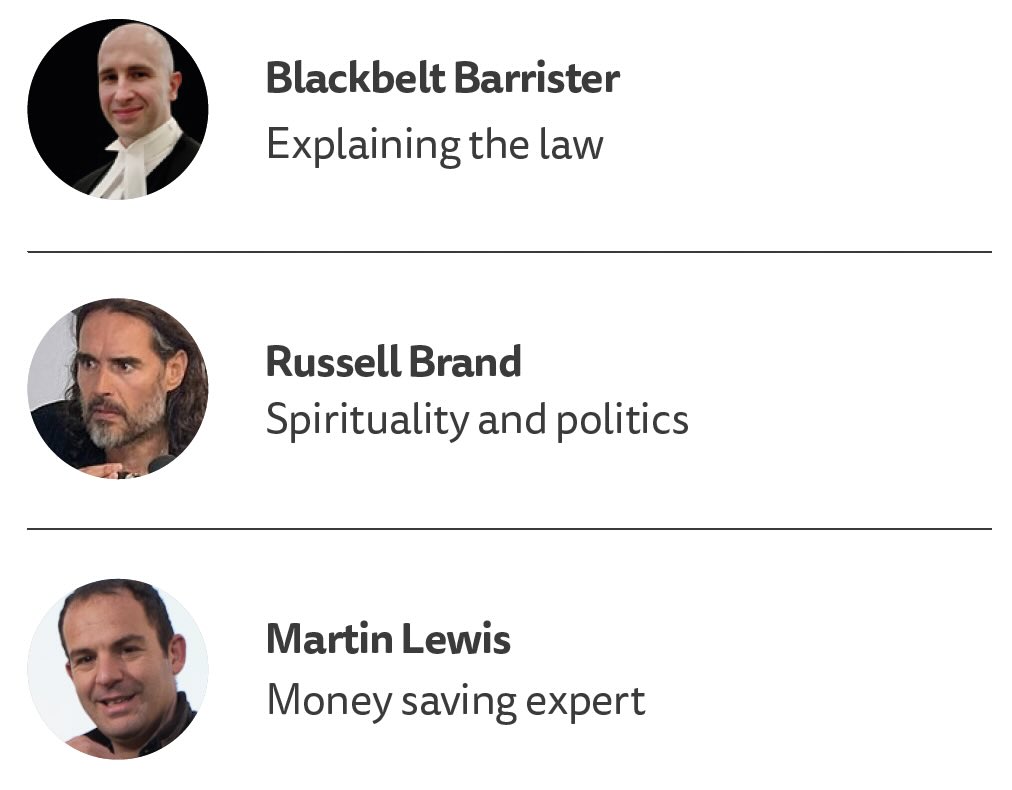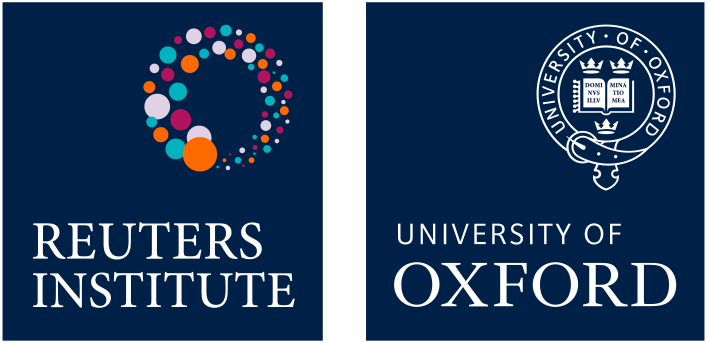
United Kingdom
Traditional brands play a significant role with many of the most named individuals in social media working directly or indirectly for one of the UK’s national news organisations. These include the political editors from ITV (Robert Peston) and Sky News (Beth Rigby). The social media accounts of BBC News, The Guardian and Sky News significantly outnumber any named individual, while GB News and some of its more controversial anchors (Neil Oliver and Nigel Farage, who is the leader of Reform UK) are also widely cited. At the same time, US commentators and podcasters such as Joe Rogan pick up a younger, right-leaning crowd in the UK. Piers Morgan, a former newspaper editor and mainstream broadcaster, has now set up his own digital operation aimed at UK, US, and Australian audiences.
Comedian Russell Brand was once one of the BBC’s top entertainment stars but has shifted his focus to social media where he promotes a mix of wellness topics and fringe theories. On his daily Stay Free with Russell Brand show he talks about distrust in the government and mainstream media and regularly platforms figures from the US alt-right. Brand continues to lean into spirituality and recently underwent a public Christian baptism. Other right-leaning YouTubers include Mayhar Tousi (Tousi TV) and Konstantin Kisin, co-host of the popular TRIGGERnometry podcast, and another former comedian. Both are highly critical of the mainstream media and so-called political correctness.
Elon Musk has made a number of recent interventions in British politics, including criticising Keir Starmer’s government over its response to grooming gangs and has also argued that the recent UK Online Safety Act (2023) is a threat to free speech in the UK. Most recently he called for a change of government when speaking at a rally in London organised by far-right leader Tommy Robinson.
Meanwhile, left-leaning UK audiences are drawn to Owen Jones, a commentator and Guardian columnist, known for his outspoken views on politics and also on the plight of Palestinians in Gaza. James O’Brien is a radio talk show host whose monologues on issues such as the negative impact of Brexit – and which frequently criticise those on the political right – regularly go viral on YouTube and TikTok. Less (or non-) partisan creators include News Daddy (Dylan Page), who has 17m TikTok followers, one of the largest news accounts on the platform. Page, who is in his twenties and not a trained journalist, has attracted Gen Z audiences all over the world for his concise and entertaining news summaries, presented in a short-form video format.
Specialist content creators include the Blackbelt Barrister, real name Daniel ShenSmith, who is a practising lawyer and mediator whose YouTube channel explains the law and legal principles. Recent videos have covered the implications for free speech of the UK’s controversial Online Safety Act and have attracted considerable attention. He is also a martial artist, holding a Black Belt in Taekwondo. Martin Lewis is a hugely popular personal finance expert who works across traditional media (ITV, BBC) and his own social media channels.
Different kinds of gurus offering advice on social media

Proportion that regularly pay attention to creators/influencers in social and video networks
12%
(21/24)
Proportion that regularly pay attention to news brands/journalists in social and video networks
16%
(23/24)
Gender balance
14
of the top 15 individuals are men
These lists represent the individuals most mentioned by respondents to our 2025 and 2024 Digital News Report surveys in the context of news and social media and video networks. Respondents who used Facebook, YouTube, X, Instagram, Snapchat or TikTok for news were asked where they paid most attention – including options for traditional news media/journalists, digital-first news outlets not associated with traditional media, creators/personalities who mostly focus on the news, creators/personalities who occasionally focus on the news. For each type, we asked respondents to name up to three examples of who they paid attention to. We then counted the individuals mostly using a tool called OpenRefine to help us use a semi-automated approach to clean the data (e.g. resolve misspellings or alternative names, remove duplicates etc.). In parallel, we also used ChatGPT5 to process and recode the original data, and to identify the most mentioned individuals to give us a way of comparing results. Further details on the tools we used and on small differences in methodology between 2024 and 2025 are provided in our methodology section.
Why did you use open fields rather than closed lists to collect the data?
We used open text response boxes, first, because in many countries the most popular news creators and influencers have not yet been identified by previous research. Second, because it would likely not be possible to fully capture the broad and fragmented nature of this ecosystem using a fixed listed of response options. And third, because we wanted to adopt an audience-centric approach whereby respondents could enter names that they considered news sources to them, even if they did not meet accepted standards or definitions within academia or the journalistic profession. This means that many of the names we list here would perhaps have been excluded under a more top-down approach.
How definitive is the order of the named individuals in each country?
In some cases, especially near the bottom the list, differences in the number of mentions for individuals are very small. Given our survey methodology, and the associated margin of error, the precise rank order should be read as indicative rather than definitive. Many other individuals were mentioned by respondents in the context of news, even if they do not make the top 15 using our approach. The lists should therefore be seen as indicative of some of the top news individuals in each country.
Why are some popular individuals with high follower counts lower down the list than individuals with high follower counts?
There are a number of possible reasons for this. First, some popular creators such as musicians and comedians are known more for entertainment than for news and their follower counts are often higher as a result. This means that even if they do occasionally talk about news related issues, not all of their followers will be aware of it. Second, some individuals working for traditional media may have relatively low personal followings but are widely distributed via social accounts of news brands. Third, there is a margin of error in surveys such as this (see previous answer) that needs to be borne in mind.
Did you exclude any individuals or other entries as part of the process?
Our lists are inclusive in terms of being faithful to the individual names mentioned by respondents. We removed just a handful of actors, sports stars, and celebrities if we were sure they did not post on any news-related issues. In most cases this did not affect the top 15 names that are published in this report for each country.
Many creators operate as part of collectives or use pseudonyms. How did you deal with these categorisation issues?
In terms of creator collectives or social-first brands, such as the Daily Wire (US) or TLDR News (UK) we followed the lead of our respondents. Where audiences have identified them as individuals, we have tended to categorise these as creators rather than news brands, but where they have mentioned a brand, we included them in our list of news brands. Where it was clear, however, that the brand is the work of one individual (e.g. Es.decirdiario/Sheila Hernández in Spain) we categorised them as an individual and made the connection clear in the description. Many creators use pseudonyms and, in these cases, we combined mentions of these with the real names. Again, we tried to make the connection clear in the description.
How did you deal with politicians and the overlap between politicians and political commentary?
Politicians and businesspeople are also frequently mentioned by survey respondents in the context of news sources on social media, and often have significant followings (e.g. on X, Donald Trump has 109m, Narendra Modi 109m, and Elon Musk 225m). Many politicians are also content creators and commentators who shape public debates. Some content creators have become politicians, and vice versa. We chose to include politicians if they were named by respondents in the context of news, but we have also shaded serving (or recently serving) politicians in grey to make clear the different relationship they often have with news consumers.

